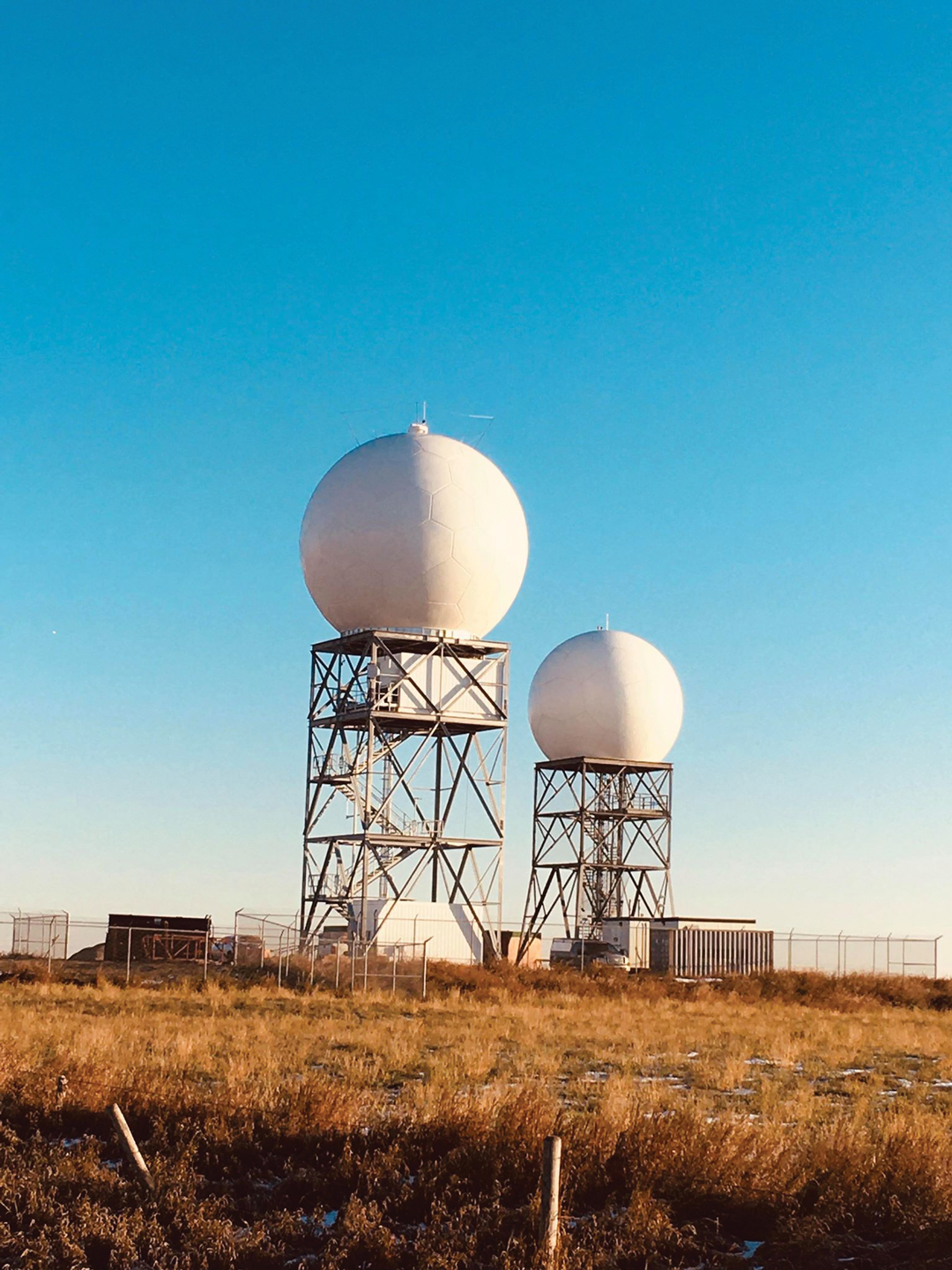POSITIVE PREDICTIONS
BY CULLEN BIRD • PHOTO OF STRATHMORE RADAR STATION COURTESY OF ENVIRONMENT CANADA
Farmers are always at the mercy of the weather, but short- and long-term weather prediction technology is better than ever, with major improvements now in development.
Advances include improved radar, better long-horizon computer models with which to create long-term forecasts and AI programs that produce immediate six-hour weather snapshots. This is an especially good thing for Alberta as the province’s geography makes forecasting a perennial challenge. “The mountains do create a lot of havoc in terms of where these storm systems are coming in,” said Dan Kulak, an Environment Canada and Climate Change Canada (ECCC) meteorologist based in Edmonton. While air masses and storms that move across the coast of British Columbia may be well defined by the weather monitoring systems in place there, these become poorly defined as they move across the Rockies, he added.
Modern meteorology uses a range of methods to gather data about the weather and create forecasts. Radar stations pick up physical matter such as precipitation or debris from storms and weather events. Satellite images illustrate the movement of clouds and storms while ground stations measure rainfall and soil moisture.
As it is, the current weather system network is set up to predominantly cover the major cities of the Prairies, said Kulak.

“The quality of forecast models for the region is notably less than it is for other places in the world,” said Drew Lerner, senior meteorologist and founder of World Weather Inc., a U.S.-based weather analysis company that focuses on agriculture. “It’s very difficult to get computer forecast models to be accurate for more than, let’s say, five to seven days down the road; things change in the Prairies very quickly.”
Besides the Rockies, many other factors feed into weather prediction on the Prairies, including Arctic air masses and moisture from the Gulf of Mexico, Lerner said. “If you go into Vancouver, Ottawa, Toronto, Montreal, what you’re going to find is the weather data quality is many times better than it is on the Prairies.” Canada could greatly improve its weather forecasting and analysis with the creation of a unified climate and weather data network, he added.
Weather data collection and historical climate databases are now fragmented, with each province creating its own system of varying quality and accessibility. “Alberta’s got a terrific data set for agricultural weather, but you go to Saskatchewan and it’s very different. It’s not the same presentation, it’s not the same quality and the network is lacking,” said Lerner. “Among folks who use weather forecasts for various purposes, there’s a lot of frustration out there that they can’t get good quality outlook.”
Major improvements to ECCC’s radar station system will certainly improve the nation’s weather forecasting. The department will spend more than $131-million to replace 27 of its 31 radar stations with new installations twice as large and powerful. One new radar site will be built in Fort McMurray.
Twelve of these new stations are now complete, while the remaining 16, including the Fort McMurray site, will be ready to go in the months leading up to 2023. The new facilities will have greatly increased range and employ dual polarization technology, which uses both horizontal and vertical radar pulses to build detailed 3D imagery of weather systems and anomalies.
This will help ECCC meteorologists distinguish between various types of precipitation and provide better advanced warning, said Kulak. Indiscernible to conventional radar, the new system can detect the hamburger shape of falling raindrops and the round shape of hail pellets.
NEW WEATHER MODELLING SYSTEMS
Short-horizon weather predictions are the focus of a new artificial intelligence (AI) “nowcasting” technology developed by Google. In January, Google announced it has developed a program that uses machine learning and historical image analysis to make one-to-six-hour rainfall predictions.
Traditional numerical computer models require up to six hours to analyze huge amounts of data to make long-term forecasts. “Optical flow” models use image analysis to predict a storm’s path, but do not take into account how much power it naturally loses over time.
Google researchers claim the AI program outperforms both numerical and optical flow models when making predictions one hour into the future. However, numerical models outperformed the nowcasting AI with predictions six hours or more into the future.
Google announced the release of MetNet in March. The new forecasting tool utilizes nowcasting and can predict weather up to eight hours into the future across the continental U.S. The company has not announced if and when it might deploy MetNet in Canada.
Weather prediction models such as MetNet based on deep neural networks have the potential to benefit farmers and the agriculture sector by improving the overall quality of forecasts, said Google brain researcher Nal Kalchbrenner, a member of the Google deep learning AI team.
MetNet may also benefit farmers “by dramatically increasing the resolution of forecasts in terms of their spatial granularity and their interval frequency, and by being able to easily analyse weather data in combination with agricultural data. [This can produce] agriculture-specific predictions beyond the core weather domain,” said Kalchbrenner.
While there are exciting possibilities in international meteorology, additional innovations are being made closer to home.
Gathering weather data is one thing, interpreting and analyzing it is another, said Lerner. “The Canadian government has opted to not adequately staff the relevant field offices across the Prairies,” he said. This has been the situation for more than a decade, he added. Though ECCC employs the right people, the department doesn’t have the manpower to provide comprehensive analysis and quality control for long-range forecasts, he said.
An ECCC representative said in an email that it is adequately staffed to meet its mandate and “exerts control” over its longterm forecasts. “Staffing levels at forecast centres nationwide allow the delivery of ECCC’s mandate and during times of increased weather activity, additional staff from other locations may be called upon to assist with surge demand,” the email read.
Overall, Canada’s weather prediction technology has undergone big improvements. ECCC is working on forecast computer models very comparable to new models in other countries, according to Lerner. “We’re definitely advancing and I don’t want to give the impression that Canada is years behind the rest of the world; that’s not the case,” he said.
Despite the increase in data variety and quantity such radar improvements will bring, Kulak said he is not concerned about interpreting the date he receives. “In general, yes, there’s going to be a lot of data coming in,” he said, adding meteorologists will require more training to handle it appropriately. Lerner emphasizes the many improvements being made to weather forecasting are good news. “There’s a lot to be excited about,” he said.







Comments